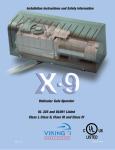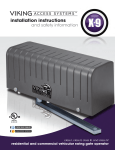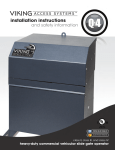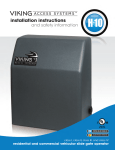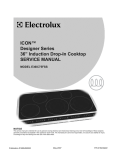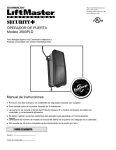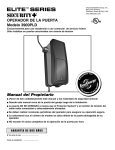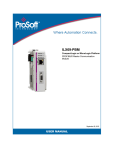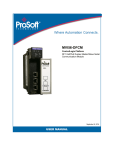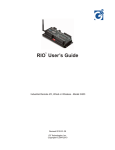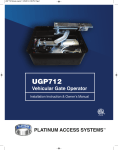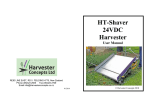Download Viking Access Systems Vehicular Gate Opener UL 325 User's Manual
Transcript
revision BØ february 2007 installation instructions and safety information LISTED 18TC UL 325 UL 991 CLASS I, CLASS II, CLASS III and CLASS IV vehicular gate operator X-9 PARTS PARTS DIAGRAM DIAGRAM WARNING - For Installation By Qualified Personnel Only. Item 1 2 3 4 5 6 7 8 9 10 11 12 Description Cover, Plastic Motor/Gear Unit Chassis, Motor/Gear Strain Relief Arm Assembly, Articulated Holder, Limit Switch Limit Switch (2) Cam, Limit Switch Terminal Block Key Release Thumb Screw Positive Stop Extension Part No. VAX9PC VAX9 VAX9CH VAX9ST VAX9AA 1 6 7 9 8 10 VAX9LS VAX9LCS VAX9TB VAX9KR VAX9TS VAX9PSE 2 11 (2) Weight 40 lb. 3 4 5 12 Overall Dimensions 14.724" 4.33" 4.33" 7.874" .985" 5.12" " 975 19.6 13. 85" Gear/Motor Unit Can Be Mounted Left or Right 1.50" 5.90" .394" 2.36" i 2.36" 2.36" TECHNICAL SUPPORT 1 800 908 0884 TABLE TABLE OF OF CONTENTS CONTENTS Parts Diagram/Parts List . . . . . . . . . . . . . . . . . . . . . . . . . . . . . . . . . . . . . . . . . . .i Important Safety Information Important Safety Instructions . . . . . . . . . . . . . . . . . . . . . . . . . . . . . . . . . . . . . .2 Important Installation Instructions . . . . . . . . . . . . . . . . . . . . . . . . . . . . . . . . .2-3 Maintenance/General Safety Precautions . . . . . . . . . . . . . . . . . . . . . . . . . . . . . .4 Terminology . . . . . . . . . . . . . . . . . . . . . . . . . . . . . . . . . . . . . . . . . . . . . . . . . .5 Photo Beam (non-contact sensor) Installation . . . . . . . . . . . . . . . . . . . . . . . . . .6 Edge Sensor (contact sensor) Installation . . . . . . . . . . . . . . . . . . . . . . . . . . . . . .7 Manual Release . . . . . . . . . . . . . . . . . . . . . . . . . . . . . . . . . . . . . . . . . . . . . . . .7 Audible Alarm Reset Switch Installation . . . . . . . . . . . . . . . . . . . . . . . . . . . . . .8 Warning Placard Installation . . . . . . . . . . . . . . . . . . . . . . . . . . . . . . . . . . . . . .8 Important Installation Information . . . . . . . . . . . . . . . . . . . . . . . . . . . . . . . . . .9 Specifications . . . . . . . . . . . . . . . . . . . . . . . . . . . . . . . . . . . . . . . . . . . . . . . . .9 Plan of Installation – Open Inside . . . . . . . . . . . . . . . . . . . . . . . . . . . . . . . . . . .10 Plan of Installation – Open Outside . . . . . . . . . . . . . . . . . . . . . . . . . . . . . . . . . .11 Gate Operator Installation Step 1 through 7 – Operator Installation . . . . . . . . . . . . . . . . . . . . . . . . . . . . .13 Step 8 through 9 – Limit Switch Setup . . . . . . . . . . . . . . . . . . . . . . . . . . . . . . .14 Opening/Closing Setup . . . . . . . . . . . . . . . . . . . . . . . . . . . . . . . . . . . . . . . . . .15 Reference Wiring Diagram; Limit Switch Connections . . . . . . . . . . . . . . . . . . . .15 Control Box Installation . . . . . . . . . . . . . . . . . . . . . . . . . . . . . . . . . . . . . . . . . . .16 Electrical Installation Electrical Installation (120/220 VAC) . . . . . . . . . . . . . . . . . . . . . . . . . . . . . . . .17 Single Unit Connections . . . . . . . . . . . . . . . . . . . . . . . . . . . . . . . . . . . . . . . . .18 Master/Slave Connections . . . . . . . . . . . . . . . . . . . . . . . . . . . . . . . . . . . . . . . .19 Vehicular Loop Detector Installation Loop Layout Diagrams . . . . . . . . . . . . . . . . . . . . . . . . . . . . . . . . . . . . . . . . . .20 Installation Guidelines . . . . . . . . . . . . . . . . . . . . . . . . . . . . . . . . . . . . . . . . . . .21 Accessory Connections Open Commands; Safety Connections . . . . . . . . . . . . . . . . . . . . . . . . . . . . . . . .22 Radio Receiver; Hold Open Timer . . . . . . . . . . . . . . . . . . . . . . . . . . . . . . . . . . .23 Viking Electromagnetic Lock . . . . . . . . . . . . . . . . . . . . . . . . . . . . . . . . . . . . . .24 Magnetic Lock; Solenoid; Guard Station . . . . . . . . . . . . . . . . . . . . . . . . . . . . . .25 Special Features Intelligent Obstruction Sensor (Primary Entrapment Protection) . . . . . . . . . . . . .26 Gate Overlap Setting . . . . . . . . . . . . . . . . . . . . . . . . . . . . . . . . . . . . . . . . . . . .28 Solar Panel Installation . . . . . . . . . . . . . . . . . . . . . . . . . . . . . . . . . . . . . . . . . . .29 Viking Hinge . . . . . . . . . . . . . . . . . . . . . . . . . . . . . . . . . . . . . . . . . . . . . . . . . . .30 Troubleshooting . . . . . . . . . . . . . . . . . . . . . . . . . . . . . . . . . . . . . . . . . . . . . . . .31-33 TECHNICAL SUPPORT 1 800 908 0884 1 IMPORTANT IMPORTANT SAFETY SAFETY INFORMATION INFORMATION WARNING - Not following these instructions may cause severe injury or death to persons. IMPORTANT SAFETY INSTRUCTIONS WARNING – To reduce the risk of severe injury or death: 1. READ AND FOLLOW ALL INSTRUCTIONS. 2. Never let children operate or play with gate controls. Keep the remote control away from children. 3. Always keep people and objects away from the gate. NO ONE SHOULD CROSS THE PATH OF THE MOVING GATE. 4. Test the gate operator monthly. The gate MUST reverse on contact with a rigid object or when an object activates the non-contact sensors. After adjusting the force or the limit of travel, retest the gate operator. Failure to adjust and retest the gate operator properly can increase the risk of injury or death. 5. Use the manual release only when the gate is not moving. 6. KEEP GATES PROPERLY MAINTAINED. Read the owner’s manual. Have a qualified service person make repairs to gate hardware. 7. The entrance is for vehicles only. Pedestrians must use separate entrance. 8. Every gate operator installation MUST have secondary protection devices against entrapment, such as edge sensors and photo beams more in particularly in places where the risk of entrapment is more likely to occur. 9. SAVE THESE INSTRUCTIONS. IMPORTANT INSTALLATION INSTRUCTIONS 1. Install the gate operator only when: a) The operator is appropriate for the construction of the gate and the usage Class of the gate (refer to page 5), b) All openings of a horizontal slide gate are guarded or screened from the bottom of the gate to a minimum of 4 feet (1.22 m) above the ground to prevent a 2-1/4 inch (57.2 mm) diameter sphere from passing through the openings anywhere in the gate, and in that portion of the adjacent fence that the gate covers in the open position, c) ALL EXPOSED PINCH POINTS ARE ELIMINATED OR GUARDED, AND d) GUARDING IS SUPPLIED FOR EXPOSED ROLLERS. 2. The operator is intended for installation only on gates used for vehicles. Pedestrians must be supplied with a separate access opening. The pedestrian access opening shall be designed to promote pedestrian usage. Locate the gate such that persons will not come in contact with the vehicular gate during the entire path of travel of the vehicular gate. 3. The gate must be installed in a location so that enough clearance is supplied between the gate and adjacent structures when opening and closing to reduce the risk of entrapment. Swinging gates shall not open into public access areas. 4. The gate must be properly installed and work freely in both directions prior to the installation of the gate operator. Do not over-tighten the operator clutch or pressure relief valve to compensate for a damaged gate. 5. The gate operator controls must be placed so that the user has full view of the gate area when the gate is moving AND AWAY FROM THE GATE PATH PERIMETER, 2 TECHNICAL SUPPORT 1 800 908 0884 IMPORTANT IMPORTANT SAFETY SAFETY INFORMATION INFORMATION WARNING - Not following these instructions may cause severe injury or death to persons. IMPORTANT INSTALLATION INSTRUCTIONS Continued 6. Controls intended for user activation must be located at least six feet (6’) away from any moving part of the gate and where the user is prevented from reaching over, under, around or through the gate to operate the controls. Outdoor or easily accessible controls shall have a security feature to prevent unauthorized use. 7. The Stop and/or Reset button must be located in the line-of-sight of the gate. Activation of the reset control shall not cause the operator to start. 8. All warning signs and placards must be installed where visible in the area of the gate. A minimum of two placards shall be installed. A placard is to be installed in the area of each side of the gate and be visible to persons located on the side of the gate on which the placard is installed. 9. For gate operators utilizing a non-contact sensor (Photo beam or like) in accordance with section 31.1.1 of the UL325 standard: a) See instructions on the placement of non-contact sensors for each Type of application (refer to page 6), b) Care shall be exercised to reduce the risk of nuisance tripping, such as when a vehicle, trips the sensor while the gate is still moving, and c) One or more non-contact sensors shall be located where the risk of entrapment or obstruction exists, such as the perimeter reachable by a moving gate or barrier (refer to page 6). d) Use only Omron E3K-R10K4 photoelectric eye to comply with UL325 10. For a gate operator utilizing a contact sensor (Edge sensor or like) in accordance with section 31.1.1 of the UL325 standard: a) One or more contact sensors shall be located where the risk of entrapment or obstruction exists, such as at the leading edge, trailing edge, and post mounted both inside and outside of a vehicular horizontal slide gate (refer to page 7). b) One or more contact sensors shall be located at the bottom edge of a vehicular vertical lift gate. c) One or more contact sensors shall be located at the pinch point of a vehicular vertical pivot gate. d) A hardwired contact sensor shall be located and its wiring arranged so that the communication between the sensor and the gate operator is not subjected to mechanical damage. e) A wireless contact sensor such as one that transmits radio frequency (RF) signals to the gate operator for entrapment protection functions shall be located where the transmission of the signals are not obstructed or impeded by building structures, natural landscaping or similar obstruction. A wireless contact sensor shall function under the intended end-use conditions. f) One or more contact sensors shall be located on the inside and outside leading edge of a swing gate. Additionally, if the bottom edge of a swing gate is greater than 6 inches (152 mm) above the ground at any point in its arc of travel, one or more contact sensors shall be located on the bottom edge (refer to page 7). g) One or more contact sensors shall be located at the bottom edge of a vertical barrier (arm). h) Use only Miller Edge Model MGR20 or MGS20 edge sensor to comply with UL325 TECHNICAL SUPPORT 1 800 908 0884 3 IMPORTANT IMPORTANT SAFETY SAFETY INFORMATION INFORMATION WARNING - Not following these instructions may cause severe injury or death to persons. MAINTENANCE Remove the Power Harness from the Control Board (refer to page 17) • Clean and lubricate the turning pins and gate hinges using the recommended lubricant. • Check that all mounting hardware of the gate operator is properly tighten. • Ensure that the gate moves freely. • Check for corroded parts and replace if necessary. • Check the battery for the following: Battery connections must be free of corrosion. Battery voltage must be 26 VDC (fully charged battery). Reconnect the Power Harness for the Control Board (refer to page 17) • Check and confirm the proper operation of all safety devices (photoelectric eye, edge sensors or like). • Check and confirm the operation of all installed accessories. • Check and confirm the operation of all special features such as the Intelligent Obstruction Sensor, Hold Open Timer (refer to page 20 to 27) • Check and confirm the operation of the manual release (refer to page 7) • Verify battery backup functionally by turning off the power source (120 VAC and 220 VAC). DO NOT FORGET TO TURN ON THE POWER SOURCE AFTER VERIFICATION. GENERAL SAFETY PRECAUTIONS The following precautions are an integral and essential part of the product and must be supplied to the user. Read them carefully as they contain important indications for the safe installation, use and maintenance. • These instruction must be kept and forwarded to all possible future users of the system. • This product must be used only for that which it has been expressly designed. • Any other use is to be considered improper and therefore dangerous. • The manufacturer cannot be held responsible for possible damage caused by improper, erroneous or unreasonable use. • Avoid operating in the proximity of the hinges or moving mechanical parts. • Do not enter the path of the moving gate while in motion. • Do not obstruct the motion of the gate as this may cause a situation of danger. • Do not allow children to play or stay within the the path of the moving gate. • Keep remote control or any other control devices out of the reach of children, in order to avoid possible involuntary activation of the gate operator. • In case of break down or malfunctioning of the product, disconnect from the main power source. Do not attempt to repair or intervene directly, contact only qualified personnel for repair. • Failure to comply with the above may create a situation of danger. • All cleaning, maintenance or repair work must be carried out by qualified personnel. • In order to guarantee that the system works efficiently and correctly it is important to have the manufacturer’s instructions on maintenance of the gate and operator carried out by qualified personnel. • In particular, regular checks are recommended in order to verify that the safety devices are operating correctly. All installation, maintenance and repair work must be documented and made available to the user. Installer: _____________________________________________________ ____________ Signature Date Contact: _________________________________________________________ _________________________________________________________ 4 TECHNICAL SUPPORT 1 800 908 0884 TERMINOLOGY TERMINOLOGY UL325 Gate Operator Classification GLOSSARY RESIDENTIAL VEHICULAR GATE OPERATOR CLASS I – A vehicular gate operator (or system) intended for use in a home of one-to four single family dwelling, or a garage or parking area associated therewith. COMMERCIAL/GENERAL ACCESS VEHICULAR GATE OPERATOR CLASS II – A vehicular gate operator (or system) intended for use in a commercial location or building such as a multi-family housing unit (five or more single family units), hotel, garages, retail store, or other building servicing the general public. INDUSTRIAL/LIMITED ACCESS VEHICULAR GATE OPERATOR CLASS III – A vehicular gate operator (or system) intended for use in an industrial location or building such as a factory or loading dock area or other locations not intended to service the general public. RESTRICTED ACCESS VEHICULAR GATE OPERATOR CLASS IV – A vehicular gate operator (or system) intended for use in a guarded industrial location or building such as an airport security area or other restricted access locations not servicing the general public, in which unauthorized access is prevented via supervision by security personnel. Install the gate operator only when: The operator is appropriate for the construction of the gate and the Usage Class of the gate. 5 TECHNICAL SUPPORT 1 800 908 0884 5 Obstruction Charger Radio Rec. Loop UL Sens Sensor Safety Loop Center Loop Center SAFETY Safety UL Radio IMPORTANT IMPORTANT SAFETY INFORMATION INFORMATION Sensor Obstruction ay Loop Sensor Rec. Power WARNING - Not following these instructions may cause severe injury or death to persons. Low Battery NOTE when Sensor the photo-beam MAX- This type of installation DOES NOT reverse the gate all the way back to its limits Motor is obstructed. This installation is only to protect against entrapment and to comply with UL325. min. Photo Beam (non-contact sensor) Installation 30 Use only Omron E3K-R10K4 photoelectric eye to comply with UL325 Make the electrical connections of the photoelectric sensor as described here in this page. Mag. LOCK Lock MAG. Care shall be exercised to reduce the risk of nuisance tripping, such as when a N.C. vehicle, trips the sensor while the gate is still moving, and Off 1 60 n Mag. Lock Hold Open Timer Secondary Entrapment Protection Hold Open Mag. Photo beams or like must be installed to reduce the risk of entrapment. Timer Lock N.O. Turn Switch to 'Light On' Position 1 (C1) 3 (NC1) +28v Gnd +28v Radio Gnd +28v Radio Station Gnd UL Gnd Reopen Safety Loop Connector Connector Gnd Gnd Exit Gnd Strike Gnd en Commands Center One or more non-contact sensors shall be located where the risk COM of entrapmentor obstruction exists, such as the perimeter reachable by a moving gate or barrier. 24VDC Omron Model E3K-R10 Shown Connection '1' (C1) Connection '3' (NC1) 24 VDC Power Connections 24 VDC Power Connections Photo Beam Unit Gate in Open Position Potential Entrapment Area (Shaded) Reflector One or more non-contact sensors shall be located where the risk of entrapment or obstruction exists, such as the perimeter reachable by a moving gate or barrier. Consult the installation manual for the UL325 device (photo beam or like) for detail information about the usage, installation and maintenance 6 TECHNICAL SUPPORT 1 800 908 0884 min. Motor Sensor MAX Mag. Lock Mag. LOCK Lock MAG. WARNING - Not following these instructions may cause severe injury or death to persons. Off 1 COM N.O. 3-Sided Edge Sensor 3-Sided Edge Sensor +28v Gnd Gnd +28v Radio Station Gnd UL Gnd Gnd Safety Loop Connector Connector Reopen Gnd Exit Gnd Strike Gnd Fire Open Commands Gnd N.C. Edge Sensor (contact sensor) Installation Center 60 30 Open Open Mag. Lock +28v Hold Open Timer IMPORTANT IMPORTANT SAFETY SAFETY INFORMATION INFORMATION Hold Open Timer Radio 0 3 Ob Low Battery Edge sensor or like must be installed to reduce the risk of entrapment. Use only Miller Edge 3-sided activation type MGR20 or MDS20 to comply with UL325 One or more contact sensors shall be located on the inside and outside leading edge of a swing gate. Additionally, if the bottom edge of a swing gate is greater than 6 inches (152 mm) above the ground at any point in its arc of travel, one or more contact sensors shall be located on the bottom edge. 1. A hardwired contact sensor shall be located and its wiring arranged so that the communication between the sensor and the gate operator is not subjected to mechanical damage. 2. A wireless contact sensor such as one that transmits radio frequency (RF) signals to the gate operator for entrapment protection functions shall be located where the transmission of the signals are not obstructed or impeded by building structures, natural landscaping or similar obstruction. A wireless contact sensor shall function under the intended end-use conditions. Manual Release When manual operation is required: Remove the cover, locate the chained key and turn the key to push the locking-pin down. At end of operations, lock the geared motor again by releasing locking-pin. Attention: Lock and release operations MUST be performed with motor NOT RUNNING. TECHNICAL SUPPORT 1 800 908 0884 7 IMPORTANT IMPORTANT SAFETY SAFETY INFORMATION INFORMATION WARNING - Not following these instructions may cause severe injury or death to persons. Audible Alarm Reset Switch Installation Manual Reset for the Audible Alarm UL325 standard requires an audible alarm to go off after two consecutive events detected by the primary entrapment protection of the gate operator (obstruction sensor). The audible alarm will continue to sound for 5 minutes or until a stop command gets actuated. 0 3 2. Using an External Stop button within the sight of the gate, away from moving parts of the gate and out of reach of children. Center Loop Obstruction Sensor 1.5 Overlap Delay Overlap Delay 1. Using the Built in Stop switch on the Control Box or Obstruction The Stop command can be actuated in two different forms Center Loop Sensor min. Sa L MAX 5' Minimum N.O. Manual Stop Button COM Warning Placard Installation All Warning Signs and Placards must be installed where visible in the area of the gate. A minimum of two placards shall be installed. A placard is to be installed in the area of each side of the gate and be visible. 8 TECHNICAL SUPPORT 1 800 908 0884 STO P Safet Loop Gnd Center Off 1 Gnd Exit Gnd Strike Gnd Gnd Fire Open Commands Open Stop Close Guard Station GND Open Stop Close UL Siren Siren STOP GND Master/Slave 60 4. The Stop and/or Reset button must be located in the line-of-sight of the gate. Activation of the reset control shall not cause the operator to start. 30 Hold Open Timer Open Stop Brake Close 3. Controls intended for user activation must be located at least six feet (6’) away from any moving part of the gate and where the user is prevented from reaching Hold Open over, under, around or through the gate Braketo operate the controls. Outdoor or easily Timer Stop Open accessible controls shall have a security feature to prevent Close unauthorized use. IMPORTANT IMPORTANT INSTALLATION INSTALLATION INFORMATION INFORMATION CAUTION - FOR USE WITH GATES OF A MAXIMUM OF 14 FT IN LENGTH AND 600 LBS. IN WEIGHT. WARNING - TO REDUCE THE RISK OF SEVERE INJURY OR DEATH TO PERSONS: This is NOT a pedestrian gate operator Do NOT Install the gate operator to lift gates 14'-0" OPEN STOP CLOSE Control Buttons 14’ maximum gate length Locate Control Buttons: 1. Within sight of the gate, 600 lb. MAX. 600 pounds maximum gate weight 2. At a minimum height of 5 feet so small children are not able to reach it, and 3. Away from all moving parts of the gate. Specifications Maximum Gate Length: Maximum Gate Weight: Maximum Aperture Angle: Power Requirements: 14 feet 600 lbs. 130 deg. 120 VAC Single Phase at 2 Amps Or 220 VAC Single Phase at 1 Amp Maximum Operating Temperature: -20°C (-4°F) to 70°C (158°F) TECHNICAL SUPPORT 1 800 908 0884 9 PLAN PLAN OF OF INSTALLATION INSTALLATION -- OPEN OPEN INSIDE INSIDE The gate must be installed in a location so that enough clearance is supplied between the gate and adjacent structures when opening and closing to reduce the risk of entrapment. Swinging gates shall not open into public access areas. C: 23-1/2" Outside Gate in Closed Position G: 4.33" Ref. H: 2.55" Ref. A: 15-3/4" Max. 90° Opening F: 15-1/2" Min. Inside Figure A – 90° Opening 7-1/4" Max. Outside C: 19-1/2" Gate in Open Position G: 4.33" Ref. H: 2.55" Ref. Gate in Closed Position 120° Opening F: 15-1/2" Min. Inside Gate in Open Position Figure B – Up to 120° Opening Open Inside Plans of Installation Note: Varying from the dimensions shown may severely affect the speed and performance of the gate operator. 10 TECHNICAL SUPPORT 1 800 908 0884 PLAN PLAN OF OF INSTALLATION INSTALLATION –– OPEN OPEN OUTSIDE OUTSIDE The gate must be installed in a location so that enough clearance is supplied between the gate and adjacent structures when opening and closing to reduce the risk of entrapment. Swinging gates shall not open into public access areas. Outside Gate in Open Position 90° C: 19-1/2" Gate in Closed Position A: 11-3/4" Max. G: 4.33" Ref. H: 2.55" Ref. Inside Figure C Open Outside Plan of Installation Note: Varying from the dimensions shown may severely affect the speed and performance of the gate operator. TECHNICAL SUPPORT 1 800 908 0884 11 GATE GATE OPERATOR OPERATOR INSTALLATION INSTALLATION CAUTION - If mounting bar is not welded to a frame member that runs the full length of the gate, the gate operator may damage the gate. Do not weld the bar or backing plate to a few pickets. STEP 1 14.173" Check the integrity of the gate structure and sufficiently sturdy such as pivot points are properly lubricated and surfaces are free of rust. 5.90" 5.90" 1.181" 3.937" a) Remove the Motor/Gear Assembly from its package. NOTE - The cover is not secured. Motor/Gear Chassis b) Disassemble the geared motor from the mounting chassis. STEP 2 1-1/2" Position the pivot bracket in accordance with figure A, B or C on page 10 or 11 and the drawing at the right. Tack weld the bracket in place. For non-ferrous gates the bracket can be bolted in place. STEP 3 Chassis Installation: Chassis can be welded to the gatepost. In the case of a non-ferrous post, anchoring the chassis may require an additional embedded bracket or special anchoring hardware to ensure the longevity of the installation. Note: Depending on type of anchor used, it may be required to enlarge the holes in the mounting chassis. 12 TECHNICAL SUPPORT 1 800 908 0884 16 GATE GATE OPERATOR OPERATOR INSTALLATION INSTALLATION STEP 4 Remount the geared motor on the chassis accordingly. STEP 5 Attach the Articulated Arms with the Positive Stop Extension to the Pivot Bracket and the Motor/Gear Assembly. NOTE - Additional holes are provided in the Pivot Bracket to assist with proper installation STEP 6 With the cover off, perform the Manual Release procedure as shown at the bottom of page 7. The gate can now be moved manually. Ensure that the gate and gate operator move freely. Check Operation Through Entire Range of Movment Once it is determined the operator will work properly, remove the operator and complete the welding process. STEP 7 Remount the gate operator. Lubricate the moving parts (the bushings on the articulated arm) and tighten the self-locking nuts in such a way as to not restrict arm movement. Leave the cover off until the Limit Switches have been adjusted. 17 TECHNICAL SUPPORT 1 800 908 0884 13 GATE GATE OPERATOR OPERATOR INSTALLATION INSTALLATION Limit Switch Setup STEP 8 Additional Cam Mounting Holes A. Loosen the screws on the limit switch cams and position the cams to the desired locations. There are additional holes provided in case of a wide or tight angle of opening or closing. B. Move the gate manually and ensure that the limit switch gets actuated at the desired open and closed position. The limit switch will click when engaged by the limit cam. Limit Switch Holder Position Cam to Suit Tighten Clamping Screw Securely Before Adjusting Cams C. Retighten the screws on the limit switch holders once the proper position has been determined. CAUTION – DO NOT OVERTIGHTEN SCREWS! D. Run the unit 2 full cycles without interruption (from limit to limit) to execute a “Learn Cycle.” E. Fine-tune the adjustment of the Limit Switch Cams. Note: Leave cover off until after the installation of the control box and the electrical installation. Verify that the operator opens and closes to the desired position under power. Make any adjustments as necessary. STEP 9 Replace the cover and secure it with screws provided after finishing final adjustments. 14 TECHNICAL SUPPORT 1 800 908 0884 18 GATE GATE OPERATOR OPERATOR INSTALLATION INSTALLATION Opening/Closing Setup: To have the gate operator slow down prior to reaching its limits use the following steps: 1. Setup the limit switches manually at the desired open and close position. 2. Allow the gate operator to run a full open and close cycle (from limit to limit) without interruption. Note: During the first full open and close cycle: The gate operator doesn’t slow down prior to reaching its limits. During subsequent cycles: The gate operator will slow down prior to reaching its limits. 3. Verify that the gate opens and closes to the desired position. To change the open or close limit position(s) the following steps MUST BE taken: Slow A. Reset the gate operator by performing one of the following steps: i. Disconnect the Power Harness Connector (see page 17) or Fast ii. Disconnect the Motor/Limit Harness Connector (see page 18 or 19) or Slow iii.Actuate both limits at the same time B. Repeat steps 1,2 and 3. Reference Wiring Diagram Note: Use this wiring diagram as a guide to connect the wires to the motor unit. Connect the lead wires as shown Wire Lead From Control Box To Limit Switches n o e ll Br o B la ue ck d Y Bl w ge w Ora n To Motor Re 0 TECHNICAL SUPPORT 1 800 908 0884 C O C N 0 N Yellow Orange N C N M The Limit Switches are wired as shown O C M Limit Switch Connections Brown Red 15 CONTROL CONTROL BOX BOX INSTALLATION INSTALLATION WARNING - If the control box is not mounted properly it may fall, causing damage and/or injury. The control box weight is approximately 40 lbs. Be sure that the substrate being mounted to and the fasteners being used are appropriate to support the weight of the control box. 1. Remove the control board mounting plate. The plate is held in the box by four screws. 15" Standard 17" Industrial 2. Position the control box in the desired place and mark the mounting holes. Prepare the holes to receive the anchors/fasteners. 14" Standard 16" Industrial Depth: 6.5" Standard 6.5" Industrial 3. Position the control box and secure it to the mounting surface using the sealed washers provided (place the rubber side of the washers against the inside of the control box). Note: Depending on type of anchor used, it may be necessary to enlarge the mounting holes in the control box. Mounting Fastener (Customer Supplied) Sealed Washer (Supplied with Unit) Control Box Mounting Surface 16 TECHNICAL SUPPORT 1 800 908 0884 15 ELECTRICAL ELECTRICAL INSTALLATION INSTALLATION Caution – Do not connect the power harness to the board until the installation is ready for verification. Power Harness The X-9 Gate Operator requires a single phase AC line to operate and charge the batteries. 1. Turn off the main switch or breaker for the power line being used. 2. Move the selector switch on the Incoming Voltage Selector to the proper position (115 for 110 to 120VAC, 230 for 200 to 240VAC). 3. Connect the incoming power wires to the terminals as shown in the illustration. 4. Turn on the main switch or breaker once Fail the installation is ready forSafe/Secure performance check and adjustments. 5. To verify that there is AC power to the system, check that the ‘Charger’ LED on the Control Board is on. Auxiliary Power Connection. See page 29 for further details. 24VAC White Green 24V BAT Red Black OPEN RIGHT OPEN LEFT Tips for proper ground installation EMI Board To Transformer 3A FUSE A good ground in a gate operator installation will minimize or prevent damage to the operator cause by natural events such as lightning strikes. Part # VAEMI The following will provide a guideline for Radio Rec. Safety Loop Center Loop UL Sens Sensor Mag. Lock Mag. Lock Mag. LOCK Lock MAG. N.C. COM N.O. +28v Gnd +28v Radio Radio Station Gnd +28v Gnd UL Gnd Reopen Safety Loop Connector Connector Gnd Gnd Exit Center Off 1 60 Gnd Strike Gnd Fire Open Commands Gnd Motor Sensor 30 Open Hold Open Timer 0 3 Stop Open Stop Low Battery d Close Power 1. Use a ground rod to provide a ground reference. 2. Consultmin. yourMAXcity code and be aware of under-ground services in the site of the gate operator to prevent inconveniences. Hold Open 3. Use alwaysTimer a single bonding point for grounding. Open 4. All ground wires must be as short and as thick as possible. 5. Prevent unnecessary turns or loops in all ground wires. un Gro Close Charger Radio Rec. th Ear GND UL Sensor P o w er G r o u n d Guard Station Safety Loop H ot Stop Center Loop N e u tr a l Close Obstruction 1.5 Overlap Delay Obstruction Overlap Delay grounding: proper Sensor Earth Ground Ground Rod TECHNICAL SUPPORT 1 800 908 0884 17 ELECTRICAL ELECTRICAL INSTALLATION INSTALLATION –– SINGLE SINGLE UNIT UNIT Single Unit Connections Connect the wires from the motor unit to the terminal block mounted next to the control board. Match wire colors to the terminal block. Obstruction Overlap Delay Open Center Loop Sensor Sensor 1.5 OPEN LEFT Connect the wire harness to the “OPEN RIGHT” connector if the gate opens towards the right side. Connect the wire harness to the “OPEN LEFT” connector if the gate opens towards the left side. OPEN RIGHT Match Colors Safety Loop UL Sensor Charger Radio Rec. Power Low Battery Open 30sec 1sec off 60sec Radio Rec. Radio UL Sensor Gnd +28v Safety Loop N.O. COM N.C. Radio Station Gnd UL Gnd Center Loop Safety Safety Connector Gnd Sensor Sensor 1.5 Gnd Obstruction Exit Overlap Delay Gnd Strike Fire Gnd Open Commands Gnd Open Stop Close GND Open Stop Close GND Guard Station Center Open Master/Slave OPEN RIGHT Stop Mag. Lock +28v Close Hold Open Timer Gnd Limit Motor Sensor MAX Mag. Lock Limit min. +28v 0 OPEN LEFT 3 Charger Power Low Battery 3 18 Limit 0 Limit ake Close Stop Open min. Motor Sensor MAX TECHNICAL SUPPORT 1 800 908 0884 Hold Open Timer 30sec Mag. Lock ELECTRICAL ELECTRICAL INSTALLATION INSTALLATION –– MASTER/SLAVE MASTER/SLAVE Master/Slave Connections A Master/SlaveControl Board is available, when required, to run two gate operators in synchronous mode. Slave Limit Open Limit Close Slave Limit Open Limit Close Obstructionprovided insert the Delay Using Overlap the connectors Center Safety UL Radio Loop Loop Sensor Rec. wires from the motor units as shown in the diagram below. Insert the connectors in the proper receptacles on the Master/Slave Control Board. The ‘Slave’ gate opens first Hold Open TimerOverlap Delay (see page 28). If the using the Slave Open gate opens in a clockwise direction, connect to the ‘Outside’ receptacle, if the gate opens in a counter-clockwise direction, connect to the ‘Inside’ receptacle Open Commands Safety Connector Radio Station Sensor L en Charger Power Low Battery Fail Safe/Secure Master Master Open Inside Outside Slave Open Inside Outside +28v Gnd +28v Radio Gnd +28v Gnd UL Gnd Safety Gnd Center Gnd Exit Gnd Strike Open Stop Close Guard Station Gnd MAG LOCK Fire Stop Gnd Fail Safe/Secure Close Brake Master Slave Blue Black Free Yellow Brown Red Open Open Orange Connect to ‘Outside’ TECHNICAL SUPPORT 1 800 908 0884 Connect to ‘Inside’ 19 p In si d e Ex it Lo op In si d e Re op en Lo op Ce nt er Lo op O Re ut op sid en e Lo o O ut si de VEHICULAR VEHICULAR LOOP LOOP DETECTOR DETECTOR INSTALLATION INSTALLATION Dimension A – 5’ for Single Gate Operator 6’ for Master/Slave Gate Operator A Outside Reopen Loop 5' A 5' Inside Reopen Loop Center Loop 5' Make Even with Open Gate Gate in Open Position 20 TECHNICAL SUPPORT 1 800 908 0884 Exit Loop Inside Outside 5' VEHICULAR VEHICULAR LOOP LOOP DETECTOR DETECTOR INSTALLATION INSTALLATION WARNING – Consult the installation instructions from the loop detector manufacturer. The following statements are provided as a guide but different requirements may be required by the vehicular loop detector manufacturer. Guidelines for Vehicular Loop Detector Installation 1. Prevent sharp corners in the geometry of the loop sensor. 2. Install the appropriate number of turns for your loop geometry based on the loop perimeter. Use Table C (below) as a guide. 3. Use XLP (cross-linked-polyethylene) type of wire. This wire reduces the effects of moisture and other environmental events in altering the functionality of the vehicular loop detector. 4. Twist the lead wire at least 6 turns per foot. 5. Use BACKER-ROD to minimize damage to the loop detector wire prior to using the sealant. 6. Place the loop detector wire and adjust the sensitivity of the vehicular loop detector unit in a way to minimize the effects of the gate over the loop detector wire. IMPORTANT – Some of the following parameters may affect the proper functionality of the vehicular loop detector (consult the installation manual and the manufacturer of the vehicular loop detector). • Gate size, • Number of turns in the loop sensor wire; • Distance from the loop sensor wire to the gate either at the open or close position. Saw Cut 1" Min. Sealant Backer-Rod Vehicular Loop Detector Wire (3 Turns Shown) Table C – Recommended Number of Turns Perimeter in Feet Number of Turns 10 5 20 4 30-40 3 50-100 2 Provide Additional Saw Cuts to Eliminate Sharp Corners 1/8" to 1/4" Saw Slot Continuously Wind Wire in Loop Slot for the Required Number of Loops (2 Loops Shown) TECHNICAL SUPPORT 1 800 908 0884 Twist Wire Outside the Loop 6 Twists/Foot Until Its Connection to the Loop Detector 21 OPEN LEFT Mag. Lock Mag. LOCK Lock MAG. UL Sens +28v Gnd UL Mag. Lock Mag. LOCK Lock MAG. Off 1 Photo Beam TECHNICAL SUPPORT 1 800 908 0884 COM N.O. +28v Gnd Radio Gnd +28v Gnd UL Gnd Reopen Gnd Center Gnd +28v Inside +28v 30 Exit N.C. Outside 22 Photo Beam COM Gnd +28v Radio Gnd +28v Gnd UL Gnd Reopen Gnd Gnd Center Off 1 Exit Edge Sensor N.C. Radio Station N.O. As an alternative to the Outside Reopen Loop, Radio Station a photo beam unit can be used as shown. Safety Loop Connector Connector Gnd Center Gnd Radio Rec. Exit Gnd Safety Loop Strike Gnd Fire Center Loop Sensor Gnd Strike Gnd Fire Gnd Open Stop Close Safety Loop Connector Connector 2 Radio Rec. UL Sens Safety Loop Keypad Mag. Lock Safety Connections Reopen Loop Detector 30 60 Gnd Strike Gnd Gnd Open Stop GND Obstruction OPEN RIGHT 60 OPEN LEFT GND Open Stop Close GND Siren Center Loop Sensor Obstruction 1.5 Open Commands Fire Delay 3 0 Hold Open Timer Center Loop Mag. Detector Lock Hold Open Timer Open Fire Override Exit Loop Detector Motor Sensor MAX Power Motor Sensor Low Battery min. Charger Radio Rec. Low Battery Hold Open FIR Timer E Obstruction The edgeCenter sensorSafety and/orULthe photoelectric Charger Radio Sensor Loopbe UL325 Loop Sensor Rec. devices.Power beam must compliant Reopen Photo Beam Gnd UL Sensor MAX The SECONDARY ENTRAPMENT PROTECTION like the edge and Master/Slave Guardsensor Station Open Commands the photoelectric beam MUST BE PART UL OF EVERY SINGLE INSTALLATION to Siren prevent pedestrian or animal entrapment (see pages 6 and 7). Open Safety Loop Safety Loop Connector Connector 1 Close Stop Vehicle loop detectors must be installed toOpen decrease the possibility of vehicle entrapment on the gate (see page 20). verlap Delay Center Loop Sensor Hold Open Timer Stop Close Brake Brake Open Commands Obstruction min. Open Fail Safe/Secure Connection Locations (Single Unit Board shown) 24VAC 24V BAT 0 3 2 1.5 Overlap Delay Overlap Delay 1 Close Guard Station Open Siren UL Siren Stop GND Close Master/Slave Reopen Open Commands Gnd Off 1 Open 30 Stop 60 Close Hold Open Timer Brake ACCESSORY ACCESSORY CONNECTIONS CONNECTIONS Hold Open Timer Open Stop Close Brake ACCESSORY ACCESSORY CONNECTIONS CONNECTIONS Safety Loop UL Sensor Charger Radio Rec. UL Sens Center Loop Radio Rec. Safety Loop Center Loop on Power Radio Receiver Low Battery Motor Sensor AX When connecting the Radio Receiver carefully verify the proper connections. The maximum voltage that the control board provides for external accessories is the maximum voltage of the battery, which is about 28 volts. Mag. Lock In the event of an electrical short the board will protect itself by shutting down and will remain shut down until the short is corrected. N.C. 24VAC The control board provides two modes of operation that a radio receiver can control the gate: COM N.O. COM NO External Accessories Gnd OPEN RIGHT having the radio receiver connected as illustrated and with the Hold Open Timer OFF (see below): Every command of the radio transmitter will control the gate as follow: a) First command opens the gate, b) Second command stops the gate and c) Third command closes the gate d) Any subsequent commands will continue in the same order to control the gate. This type of configuration is not recommended for a commercial installations. OPEN LEFT 1 Open-Stop-Close Fail Safe/Secure 1. By 24V BAT +28v Gnd +28v Radio Gnd +28v Radio Station Gnd UL Gnd Gnd Safety Loop Connector Connector Reopen Center Gnd Off 1 Mag. LOCK Lock MAG. Mag. Lock n r +24VDC Open Only 2 Radio Rec. Safety Loop 2. By having the radio receiver connected as illustrated and with the Hold Open Timer Charger UL Radio ON (see Rec. below): Sensor Power Each command of theLow radio transmitter is Battery ALWAYS AN OPEN COMMAND to the gate. UL Sens Safety Loop Center Loop Sensor Obstruction Center Loop Sensor 0 3 1.5 Overlap Delay Overlap Delay 1 Obstruction Motor Sensor min. MAX Connection Locations (Single Unit Board shown) Mag. Lock TECHNICAL SUPPORT 1 800 908 0884 +28v Gnd +28v Radio Gnd +28v Gnd UL Gnd Reopen Gnd Center Off 1 Exit Gnd Strike Gnd Fire Open Commands Gnd Open Stop Close GND Guard Station Mag. LOCK Lock MAG. 30 60 Open The Hold Open TimerMag. function holds the gate at Lock the open position for a predetermined amount of time, prior to closing automatically. Set the Timer to the desired time, from 1 to N.C. 60 seconds. COM If this feature is not needed, turn the Trim Pot clockwise to the “off”N.O. position. Note: The Hold Open Timer Safety Loop Connector Connector Radio Stationaffects the “radio receiver command” and the sequence of operation for the gate (see page 23). 2 Gnd Hold Open Timer Stop Close Hold Open Timer Open Stop Close Hold Open Timer 23 M-2 ™ VIKING VIKING ELECTROMAGNETIC ELECTROMAGNETIC LOCK LOCK Standard Features • • • • • • Mounting base with electrical box Mounting Plate/Juction Box (Weld to Post) 24VDC Plug-in transformer Magnetic Lock 12VDC or 24VDC operation Mounting Screw (4) 500mA at 12VDC operation Mounting Screw Weather Cover (4) 250mA at 24VDC operation 1300 pounds of holding force Floating Plate Guide Pin (2) Use long or short pin depending on number of spacers used Flexible Washer Mounting Plate Floating Plate Magnetic Lock Mounting Plate/ Juction Box Spacer (0 to 3) Use to adjust gap between Floating Plate and Magnetic Lock Mounting Plate (Weld to Gate) 7.5" 10.625" Cover Plate Cover Plate Mounting Screw (4) Set Screw (Locks Floating Plate Mounting Screw) 24 Volt DC Transformer (Supplied with Lock Kit) Floating Plate Mounting Screw 2.100" 3.000" to 3.125" (example) External supply for the magnetic lock must be provided. This will prevent rapid drainage of the battery in the event of power failure. Connection Location Relay Contact 10A-250VAC Magnetic Lock 24VDC Transformer (Supplied with Lock Kit) 4-wire Cable (Supplied with Lock Kit) Green Reopen Gnd y Connector Radio Station N.C. Mag. Lock COM UL Loop Conne Radio Station N.O. Gnd +28v Gnd Radio White Red Mag. Lock This Magnetic Lock is an OPTIONAL ACCESORY available from Viking Access Systems. Please order part number VA-MAG13. Mag. Lock Mag. Lock TECHNICAL SUPPORT 1 800 908 0884 Motor Sensor Motor Sensor Low Battery Low Battery Sa L S Sensor R R oop Rec. Power 24 +28v Gnd 24VDC +28v Black OPEN RIG 24VAC Magnetic Lock Off 1 +28v Gnd COM MAX Hold Open Timer 2 N.O. N.O. N.O. OPEN STOP CLOSE COM 24 TECHNICAL SUPPORT 1 800 908 0884 25 Gnd Exit Gnd Strike Gnd Gnd Fire Open Commands Open Stop Close GND Open Stop Guard Station Center Off 1 Open 30 Hold Open Timer 60 Place the control switch box within sight of the gate, away from moving parts of the gate and out of reach of children. Close Siren UL All three switches must be Normally Open Siren type of switch, and can share the same common (ground). Master/Slave Center Loop Sensor min. Open Stop Gnd +28v Stop Close GND The guard station provides control of the gate operator to open, stop and close the gate. Center Loop Sensor Obstruction Obstruction N.O. Close +28v 0 3 Mag. LOCK Lock MAG. Radio Gnd +28v Gnd Brake N.C. Radio Station Brake UL Gnd Reopen Gnd Center Off 1 Gnd Exit Guard Station Safety Loop Connector Connector 1.5 Overlap Delay Overlap Delay 30 60 Gnd Strike Gnd Fire Contact 10A-250VAC Open Commands Gnd +28v Radio Mag. Lock Radio Rec. +28v Gnd UL Gnd UL Sens Safety Loop Reopen Gnd Gnd Exit Center Center Loop Hold Open Timer Open Stop Open Motor Sensor Mag. Lock for the solenoid connection must be provided. This will prevent rapid drainage of the battery in the event of power failure. Stop Close 1 Hold Open Timer Stop Open External supply Mag. LOCK Lock MAG. 30 60 Gnd Sensor Obstruction Strike Gnd Fire 0 1.5 Gnd 3 Overlap Delay Open Stop Close Close GND MAX N.C. COM Charger N.O. Power Radio Station Low Battery Radio Rec. Solenoid Connection Relay Guard Station GND Mag. Lock Mag. Lock 1 Hold Open min. Low Battery Relay Contact 10A-250VAC Motor Sensor OPEN RIGHT Radio Rec. UL Sens OPEN LEFT Hold Open Timer Safety Loop Center Loop Sensor 1 MAX Viking AccessObstruction Systems can supply an Overlap Delay Center Safety UL Sensor excellent Magnetic Lock unit Loop (part Loop number Sensor See page 24 forSafety more details. Guard StationVA-MAG13). Open Commands Loop Connector Connector Close Open External supply for the magnetic lock must Charger UL provided. Radio be This will prevent rapid drainage Sensor Rec. Power of the battery in the event of power failure. Safety Loop Timer Connection Locations Stop(Single OpenUnit Board shown) Close Slave Center Loop Sensor Gnd 0 Obstruction 1.5 Obstruction min. Open Stop Close 2 3 Overlap Delay Overlap Delay Open Stop 24V BAT Fail Safe/Secure Slave Stop OPEN LEF ACCESSORY ACCESSORY CONNECTIONS CONNECTIONS SL SPECIAL SPECIAL FEATURES FEATURES Intelligent Obstruction Sensor (Primary Entrapment Protection) 0 Safety Loop Center Loop Sensor Obstruction Safety Loop Se MAX Hold Open Timer Turning the Trim Pot clockwise increases the sensitivity. Hold Open Open Turning the Trim Pot counterTimer clockwise decreases the sensitivity. Open 60 1. Stop the gate’s movement and reverse it momentarily. Off 1 Stop Close Center Loop Sensor min. The Obstruction Sensor detects obstructions in the path of the traveling gate. The Trim Pot for the Obstruction Sensor adjusts the sensitivity level that triggers the Sensor. When the Obstruction Sensor detects an Stop Close obstruction it will: Obstruction 30 3 Trim Pot Location (Single Unit Board shown) 1.5 Overlap Delay Overlap Delay 2. Bring the gate to a resting position. 2. Bring the gate to a resting position. 3. Disable the Gate Operator. UL325 standard requires an audio alarm to go off after two consecutive entrapment events sensed by the Inherent Entrapment Protection of the Gate Operator. The audio alarm will sound for a period of 5 minutes or until the “Stop” Button is pressed (see page 8 for remote installation of a “Stop” Button). 26 TECHNICAL SUPPORT 1 800 908 0884 25 Gnd Reopen Safety Loop Connecto Connecto Gnd Gnd Exit Gnd Strike Gnd Fire Gnd 1. Stop the gate’s movement. Open Stop Close GND gate reaches either limit it will: Open Stop Close GND If another obstruction detected before theOpen Commands Master/Slave Guardis Station Center 3. Disable the Hold Open Timer feature until the Gate Operator receives a new command. 27 TECHNICAL SUPPORT 1 800 908 0884 27 SPECIAL SPECIAL FEATURES FEATURES Gate Overlap Setting Setting the Overlap Delay Pot to “0” will cause the master and the slave units to open and close at the same time A Master/Slave control board is required to operate two gates with a single controller. Obstruction Overlap Delay Center Loop Sensor 1.5 3 Limit Hold Open Timer Siren Master Unit Opens First Slave Unit Inside 28 TECHNICAL SUPPORT 1 800 908 0884 28 Gnd UL Gnd Safety Safety Connector Gnd Exit Gnd Strike Gnd Open Commands Fire Gnd Outside Open 1sec off 60sec Guard Station Stop N.C. COM N.O. Mag. Lock 30sec for up to 3 seconds. Close The time delay can MAG LOCK be set Open Center Setting the Overlap Delay Pot to any value Close Stop other than zero will cause the master unit to delay in opening. Gnd Trim PotLimit Location (Master/Slave Unit Board shown) UL 0 K Mag. Lock Mag. Lock SOLAR SOLAR PANEL PANEL INSTALLATION INSTALLATION Motor Sensor Low Battery Power Charger cure 24VAC Replace the existing batteries with a battery pack of 33AHr or greater. Connect Leads from Solar Panel(s), Polarity is not important STEP 4 + – + – Red Wire Black Wire + – Connect New Batteries to Existing Leads Observing Polarity Reuse Existing Battery Fuse Holder July 14 12 10 8 5 2 *With a 40 Watt (24VDC) Panel System. NOTE – 1. Remember that the sun is your only source of energy. 2. The greater capacity of the batteries, the longer the system will operate on cloudy days. 3. If more spcific information is needed, please consult with Viking Access Systems. For more information regarding solar energy refer to http:/www.nrel.gov. TECHNICAL SUPPORT 1 800 908 0884 29 l 24V BAT Cut the Leads to the Toroidal Transformer STEP 3 January Radio Rec. Connect To Gate Operator Input Block STEP 2 Number of Cycles per Day* UL Sensor Use a 24V solar panel or two solar panels of 12V in series with a total capacity of 40 Watts.. OPEN LEFT + – + – OPEN RIGHT STEP 1 Refer to the maps provided to get an idea about the number of cycles the gate will be operated per day. This figure is for a single gate operator with just: a) One Radio reiver, b) One low voltage low current loop detector and c) One low voltage, low current photo cell UL Sens 12 VDC Panels 24 VDC Panel Connect the solar panel cables to the power harness as shown. Make sure you cut the wires coming from the toroidal transformer. Radio Rec. For Viking Vehicular Gate Operators H- 4 ™ VIKING VIKING HINGE HINGE These Hinges are OPTIONAL ACCESORIES available from Viking Access Systems. Please order part number VA-HD. Standard Features • • • • Self-lubricating oil impregnated bronze bushing Port for adding a Zirk fitting 3000 lbs. capacity per pair Heat-treated stainless steel pin Set Screw (Can be removed to add lubrication) Bronze Bushing Hinge Pin (0.780" Diameter) 6.563" (Installed) 1.563" 3.187" 2.375" 30 TECHNICAL SUPPORT 1 800 908 0884 TROUBLESHOOTING TROUBLESHOOTING Gate does not run – Motor Sensor indicator comes ON Check all motor connections to be fully engaged. Refer to page 18 and 19. Ensure that the motor connections are: a) Properly connected; b) Tight enough and; c) Match color code. Refer to page 15. Check that all motor cable connections, junctions and extensions are properly connected and color-coded. Refer to page 15. Check the 15 Amp fuse in the control board Gate does not run – Motor Sensor indicator is OFF Check all motor connections to be fully engaged. Refer to 15. Check that limit switches are connected to the common and the normally close position refer to page 15. Check that the stop command is not active. Refer to page 8 and 25 Check that the UL command (photo beam and/or edge sensor) is not active. Refer to page 6, 7 and 22. Check that the vehicular loop detectors are working properly. Refer to page 20, 21 and 22. Check that the radio command is not active. Refer to page 23. Ensure that you external accessories are working properly. Check the 4 Amps fuse in the control board Ensure that you power cables are adequate in voltage and properly connected. Refer to page 17. Gate does not run – Power failure Check the 15 Amp battery fuse. Refer to page 16 Check the battery connections and cables. Check the voltage of the battery. Gate does not run – Obstruction sensor ON and audio alarm is SOUNDING Ensure that the gate path is clear of obstructions. Note: To stop the audio alarm, use the stop command. Refer to page 8 and 25. If necessary, adjust the trim pot for the obstruction sensor. Refer to page 26 Gate runs, stops and reverse momentarily – Obstruction sensor ON and audio alarm OFF Ensure that the gate path is clear of obstructions. Check for proper functionality and lubrication of the gate and hardware (hinges and the like). Adjust the trim pot of the obstruction sensor. Refer to page 26. Gate ignores the limit switches 29 Check that the open limit switch and close limit switch are in the corresponding place. Refer to page 15. Check that all motor cable connections, junctions and extensions are properly connected and color-coded. Refer to 15. Ensure that the motor cable is away from sources of electrical interference, such as a) Electric motors b) Electric fences c) Power lines Check that the limit switch is not faulty Check that wires to the limit switch are not shorted. Note: To minimize effects cause by electrical interference use twisted pairs of cables with the shield grounded. TECHNICAL SUPPORT 1 800 908 0884 Se habla Español 31 TROUBLESHOOTING TROUBLESHOOTING Gate does not open or close Check all motor connections to be fully engaged. Refer to page 15. Check that limit switches are connected to the common and the normally close position refer to page 15. Check that the stop command is not active. Refer to page 8 and 25. Check that the UL command (photo beam and/or edge sensor) is not active. Refer to page 6, 7 and 22. Check that the vehicular loop detectors are working properly. Refer to page 20, 21 and 22. Check that the radio command is not active. Refer to page 23. Ensure that you external accessories are working properly Automatic close does not function Check that the trim pot of the hold open timer is set to the proper time delay. Refer to page 23. Note: Hold open timer closes the gate automatically once the gate reaches the limit open. The time delay to close is set by the trim pot. To turn this system off turn the trim pot all the way clockwise. Verify proper functionality of: Photo beam(s) Loop Detectors Radio Receiver that may prevent closing the gate. Gate opens in the opposite desired direction Verify your motor cable is connected to the proper connector. Refer to page 18 and 19. Check that all motor cable connections, junctions and extensions are properly connected and color-coded. Refer to 15. On a Master/Slave installation, one gate runs in the opposite direction Check the motor and limit switch wiring. Refer to page 15 and 19. 32 Verify that one unit is connected as open inside and one unit is connected as open outside. Refer to page 19. TECHNICAL SUPPORT 1 800 908 0884 29 TROUBLESHOOTING TROUBLESHOOTING Gate opens after few second delay Set the overlap delay trim pot to 0. Refer to page 28. Note: Overlap trim pot is normally recommended to use in overlapping gates. Refer to page 28. Gate opens. Closes or stops on its own Check that your external devices are working properly Check that your wires from your accessories are: a) Not shorting together b) Not shorting a power line c) Not shorting to metal or earth ground. L-3 unit runs slower than normal Set the overlap delay trim pot to 0. Refer to page 28. Note: Overlap trim pot is normally recommended to use in overlapping gates. Refer to page 28. ‘Charger’ LED off. Gate does not run - alarm sounds upon any input command Check the 4 Amp fuse on the control board. Check the 3 Amp fuse on the EMI control board. Refer to page 17. Make sure the incoming AC line is properly connected. Refer to page 17. Check the incoming high voltage power supply. Check the proper selection of power supply (120/220 VAC). Refer to page 17. Verify the EMI board by reading high voltage across the (4) blue and red wires at the terminal block connections. Battery voltage reads zero or very low Ensure the batteries are connected as follows: a) Left battery - Black terminal connected to the black wire from the harness (jacketed wire) b) Left battery - Red terminal connected to the red wire from fuse holder c) Right battery - Black terminal connected to the red wire from fuse holder d) Right battery - Red terminal connected to the red wire from the harness (jacketed wire) TECHNICAL SUPPORT 1 800 908 0884 33 UL325 and UL991 listed by Underwriter Laboratories (UL). Accessible manual release via key operated mechanism. Easy solution for complex installations. Elegant design,appealing to any architectural project. Opening up to 130°. Operation speed of 10 to 13 seconds per 90°. 100% duty cycle under very wide temperature range. Very low power consumption. 800 cycles of operation on backup battery (500 lb. gate and 12’ length). Intelligent speed control with smooth start and stop, self-adjust system. Modulated speed regulator prevents exceeding operating speed that may reduce the service life of the gate operator and/or installation. Intelligent obstruction detection with adjustable sensitivity Overlap delay holds one gate momentarily by an adjustable time while the other gate is operating (Master/Slave installation with overlap gates) Built-in protection against lightning strikes or similar electrical surges. Inherent overload protection in the regulated power supply for external accessories with multiple devices of protection. Modular connectors for easy installation. LED indicators for verification of operation. Solar panel and low voltage wiring compatibility. 24 VAC auxiliary power. Viking Access Systems T 800.908.0884 • F 949.753.1640 631 Wald - Irvine, CA 92618 vikingaccess.com




































